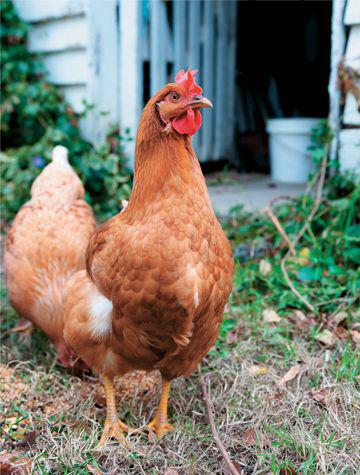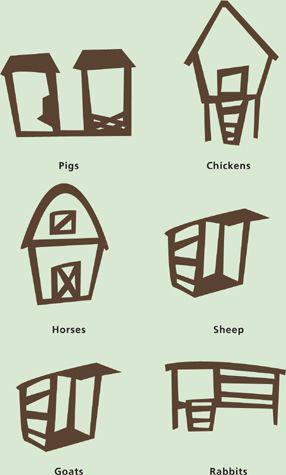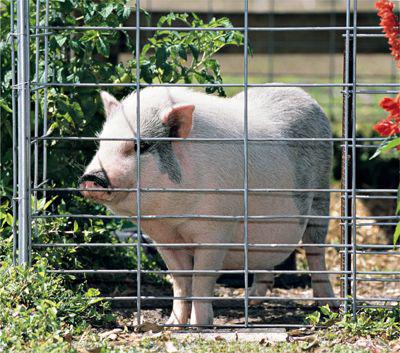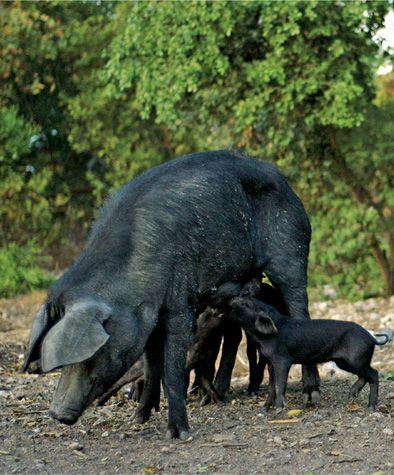DIY Projects for the Self-Sufficient Homeowner: 25 Ways to Build a Self-Reliant Lifestyle (27 page)
Authors: Betsy Matheson
Tags: #Non-Fiction


Raising small farm animals can be a challenge and it is a
serious responsibility, but once you’ve taken the plunge the rewards can be so great that it is very difficult to go back. You’ll find a number of reasons why chickens and other small animals can be a great addition to the self-sufficient home: In addition to the companionship and fun they provide, they can be a great source of wool, milk, meat, and eggs (depending on species of course).

Chickens
are probably the most popular farm animal when it comes to fitting in to a city lifestyle (see Building a Chicken Ark,
page 115
). In recent years, many larger cities have relaxed their restrictions on keeping animals, so if you’ve been turned down in the past it might be worth checking again.
If your animal experience is limited to walking your dog and emptying the cat box, it’s a good idea for you to start small in your livestock adventure. Chickens are an excellent indoctrination—they require little space, are easy to care for, and provide the reward of fresh eggs and/or lean, free range meat. As you consider which animals you’d like to purchase, consider how different species will fit your land, temperament, experience, and time allowance. If you’re a beginner, wait until you grow more confident before adopting notoriously flighty sheep, or a conniving goat that will try to outsmart you.
Also, it’s important to select animals that will be comfortable on your property. How hot or cold is the region where you live? While you can make accommodations by choosing the right shelter for your animal, some extreme climates simply are not suitable for every animal. Before you purchase livestock, contact local veterinarians and find out whether they will treat the species you plan to buy. If you cannot find a vet in your area who will treat the llama you’re planning to purchase, find out how far you’ll have to drive
to reach someone who will, and weigh this into your decision. Also, think through the logistics of how you will transport your animal and the time it will take to reach the vet.
Lastly, check with your municipality to find out what the limitations are when it comes to owning livestock. If you live in the city, you may need to request permission from your neighbors to house animals, and some species may not be allowed at all. There may also be setback requirements that apply to animal housing—take these into consideration when planning out the site for your animals’ home.
Match Your Shelter to Your Animal

Every species has different needs
regarding the type of shelter they require to grow up healthfully. Research the specific needs of your animal before you build a new shelter or convert an existing one.
 Animal Infrastructure
Animal InfrastructureBefore you introduce animals to your backyard, prepare your property for their arrival. Think of it as building a nest—consider where the animals will sleep, what they will eat, and where they will roam and play. Build fencing and shelter, provide a water source and feed area, and find a dependable veterinarian who can administer immunizations. You’ll also need to determine whether your property is zoned for the type of animals you want to raise, what limits apply in terms of animal shelter setbacks, grazing requirements, and whether or not you’ll need to apply for licenses, permits, and community permission.
A barn is not necessary for every species, though most animals require some type of shelter for protection from the elements and, perhaps, for sleeping. The type of roof you put over animals’ heads depends largely on where you live. In the chilly north, animals will require a more sturdy, draft-resistant abode than in the hot and dry southwest. Build your shelter to suit your climate—in cold climates, your shelter should be designed to keep animals warm, and in warm climates, designed to keep animals cool. Tailor your shelter to meet your animals’ needs. For example, pigs require separate space for eating and sleeping, whereas sheep and goats just need a dry shelter to protect them from the elements.
 Fencing
FencingThe species of animals you keep will determine the kind of fencing you should build to protect them. Goats are especially tricky and will gnaw and break through fencing. Your best bet for goats is a woven-wire fence with posts of steel or wood, with added protection from two strands of barbed wire, one at the top and one at the bottom of the fence. Pigs like to outsmart fencing systems, hence the phrase “hog-tight fence.” Build a fence of woven wire or permanent wood at least three feet tall.
Some species really do not care to try to get out, but you do need a fence to protect them from predators. A fence tall enough to keep out predators in your area—typically five feet or so—will work for these animals.

A good, strong fence
is the best insurance you can obtain for goats, hogs, and other animals with a strong sense of wanderlust.
 Pigs
PigsPigs are personable and intelligent. They also offer a well-rounded learning experience for new animal owners: lessons on the importance of feed mix, daily pigpen cleaning to prevent disease (and smell!), and good old-fashioned recycling. Their composted byproduct is rich fertilizer for your garden.
Pigs don’t require a great deal of land, but they do need a dry, draft-free shelter to protect them from the elements. Be sure to prepare this space before bringing home your new pets. You can dedicate a portion of an existing building, such as a barn or shelter, or construct a simple outbuilding. Ideally, the floor should be concrete and sloped for optimal drainage during daily hose-outs. A dirt floor is also fine as long as you replace hay bedding daily.
Pigs also require a separate sleeping and feeding area. A five foot by five foot square sleeping area will accommodate two pigs. The feed area should be twice this size and contain the feed trough, a watering system, and a hose connection. This serves the double purpose of instant water refills for thirsty pigs and accessibility to your number one pigpen-cleaning tool.
Contain your pigs with a secure fence of woven wire or permanent board (see
page 108
). The fence should be about three feet tall. Pigs are immensely social animals and love the spotlight, so be sure to spend time with them to help them grow healthy and happy.
